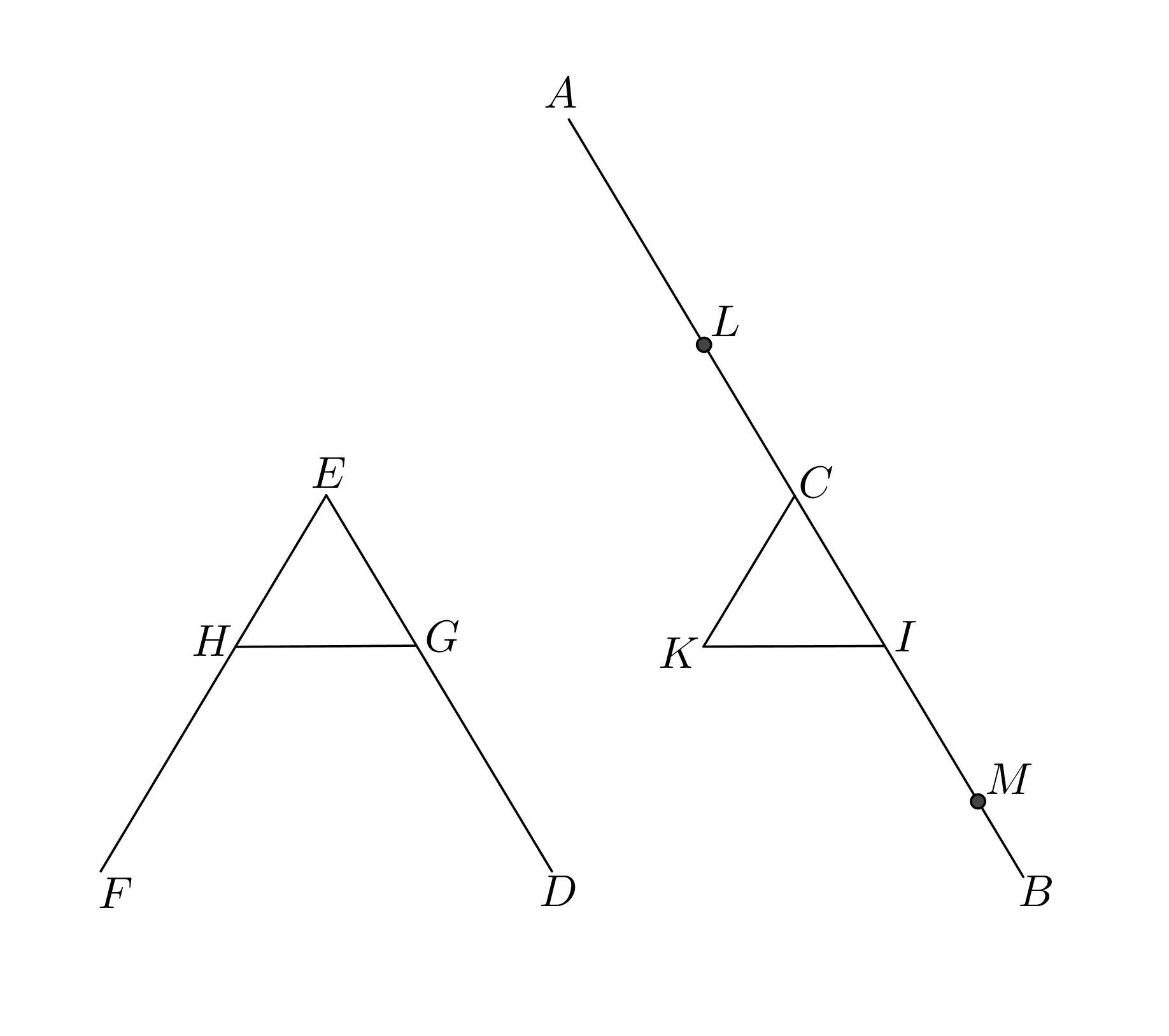Book I of Euclid’s Elements and application of areas
Taisbak [32, pp. 28–29]:
It may be appropriate to introduce the The Helping Hand, a well-known factotum in Greek geometry, who takes care that lines are drawn, points are taken, circles described, perpendiculars dropped, etc. The perfect imperative passive is its verbal mask: ‘Let a circle have been described with centre and radius ’; ‘let it lie given’ keistho dedomenon. No one who has done the Elements in Greek will have missed it; never is there any of the commands or exhortations so familiar from our own class-rooms: ‘Draw the median from vertex ’, or ‘If we cut the circle by that secant’, or ‘Let us add those squares together’. Always The Helping Hand is there first to see that things are done, and to keep the operations free from contamination by our mortal fingers.
On the perfect passive imperative, cf. Priscian, Institutiones Grammaticae: Book 8, Keil, 1870, II: 406, 15–27; 407, 1–9; Book 18, Keil, 1870, III: 238, 12–26.
Netz [29, p. xvii]:
As is explained in chapter 1, most of the diagrams in Greek mathematical works have not yet been edited from manuscripts. The figures in modern editions are reconstructions made by modern editors, based on their modern understanding of what a diagram should look like. However, as will be argued below, such an understanding is culturally variable. It is therefore better to keep, as far as possible, to the diagrams as they are found in Greek manuscripts (that is, generally speaking, in Byzantine manuscripts).
Netz [29, p. 16]:
Diagrams, as a rule, were not drawn on site. The limitations of the media available suggest, rather, the preparation of the diagram prior to the communicative act – a consequence of the inability to erase.
Netz [29, p. 25]:
What we see, in short is that while the text is being worked through, the diagram is assumed to exist. The text takes the diagram for granted. This reflects the material implementation discussed above. This, in fact, is the simple explanation for the use of perfect imperatives in the references to the setting out – ‘let the point have been taken’. It reflects nothing more than the fact that, by the time one comes to discuss the diagram, it has already been drawn.
Netz [29, pp. 94–95]:
That numbers are absent from the original is not just an accident, the absence of a tool we find useful but the Greeks did not require. The absence signifies a different approach to definitions. The text of the definitions appears as a continuous piece of prose, not as a discrete juxtaposition of so many definitions. …. So the principle is this. Mathematical texts start, most commonly, with some piece of prose preceding the sequence of proved results. Often, this is developed into a full ‘introduction’, usually in the form of a letter (prime examples: Archimedes or Apollonius). Elsewhere, the prose is very terse, and supplies no more than some reflections on the mathematical objects (prime example: Euclid).
I suggest that we see the shorter, Euclid-type introduction as an extremely abbreviated, impersonal variation upon the theme offered more richly in Archimedes or Apollonius. Then it becomes possible to understand such baffling ‘definitions’ as, e.g., Elements I.3: ‘and the limits of a line are points’. This ‘definition’ is not a definition of any of the three nouns it contains (lines and points are defined elsewhere, and no definition of limits is required here). It is a brief second-order commentary, following the definitions of ‘line’ and ‘point’. Greek mathematical works do not start with definitions. They start with second-order statements, in which the goals and the means of the work are settled. Often, this includes material we identify as ‘definitions’. In counting definitions, snatches of text must be taken out of context, and the decision concerning where they start is somewhat arbitrary. (Bear in mind of course that the text was written – even in late manuscripts – as a continuous, practically unparagraphed whole.)
….
Most definitions do not prescribe equivalences between expressions (which can then serve to abbeviate, no more). They specify the situations under which properties are considered to belong to objects. Now that we see that most definitions are simply part of the introductory prose, this makes sense. There is no metamathematical theory of definition at work here. Before getting down to work, the mathematician describes what he is doing – that’s all.
Netz [29, p. 238]:
The first floor of Greek mathematics is the general tool-box, Euclid’s results. To master it, even superficially, is to become a passive mathematician, an initiate.
The second floor is made up of such works as the first four books of Apollonius’ Conics; other, comparable works are, e.g. works on trigonometry. Such results are understood passively even by the passive mathematician, the one who knows no more than Euclid’s Elements. They are mastered by a creative mathematician in the same way in which the first floor is mastered by the passive mathematician.
The third floor relies on the results of the second floor. This is where the professionals converse. They have little incentive and occasion to master this level in the way in which the second floor is mastered. What is more important, the cognitive situation excludes such mastery, for oral storing and retrieval have their limitations. Already the second floor is invoked only through some very specific results. When Archimedes entered the scene, the tool-box was already full. Mathematics would explode exponentially only when storing and retrieval became much more written, and when the construction of the tool-box was done methodically rather than through sheer exposure.
Proclus 83–84 [26, pp. 68–69]:
The book is divided into three major parts. The first reveals the construction of triangles and the special properties of their angles and their sides, comparing triangles with one another as well as studying each by itself. Thus it takes a single triangle and examines now the angles from the standpoint of the sides and now the sids from the standpoint of the angles, with respect to their equality or inequality; and then, assuming two triangles, it investigates the same properties in various ways. The second part develops the theory of parallelograms, beginning with the special characteristics of parallel lines and the method of constructing the parallelograms and then demonstrating the properties of parallelograms. The third part reveals the kinship between triangles and parallelograms both in their properties and in their relations to one another. Thus it proves that triangles or parallelograms on the same or equal bases have identical properties; it shows [what is the relation between] a triangle and a parallelogram on the same base, how to construct a parallelogram equal to a triangle, and finally, with respect to the squares on the sides of a right-angled triangle, what is the relation of the square on the side that subtends the right angle to the squares on the two sides that contain it. Something like this may be said to be the purpose of the first book of the Elements and the division of its contents.
First part: 1–26, second part: 27–34, third part: 35–48; cf. Proclus 352–353 [26, p. 275] and 395 [26, p. 311].
Proclus 203 [26, p. 159]:
Every problem and every theorem that is furnished with all its parts should contain the following elements: an enunciation, an exposition, a specification, a construction, a proof, and a conclusion. Of these the enunciation states what is given and what is being sought from it, for a perfect enunciation consists of both these parts. The exposition takes separately what is given and prepares it in advance for use in the investigation. The specification takes separately the thing that is sought and makes clear precisely what it is. The construction adds what is lacking in the given for finding what is sought. The proof draws the proposed inference by reasoning scientifically from the propositions that have been admitted. The conclusion reverts to the enunciation, confirming what has been proved.
Netz [29, pp. 10–11]:
-
enunciation=protasis
-
exposition=setting out=ekthesis
-
specification=definition of goal=diorismos
-
construction=kataskeuē
-
proof=apodeixis
-
conclusion=sumperasma
Mueller [27, p. 11]: protasis, ekthesis, diorismos, kataskeuē, apodeixis, sumperasma
Al-Nayrizi [24, p. 102]:
The figures, all of them, theorems and constructions, have been named with a common name, and each one of them, namely, theorem and construction (and locating too, if it is something else apart from the two of them), is divided into six divisions, namely, proposition, exemplification, separation, construction, proof, and conclusion.
Al-Nayrizi [24, p. 102]:
The separation is what separates what is requested in the proposition, what is set down in the exemplification, from its common genus and requests that it be constructed and proved.
Al-Nayrizi [24, p. 103]:
The conclusion is what teaches the proposition, as when you say, “We have now proven that in every triangle, the three angles are truly equal to two right angles.” We say it with confidence since it has been proven, and for that reason we do not add anything at all to it except “therefore.”
Proclus 207 [26, p. 162]:
Furthermore, mathematicians are accustomed to draw what is in a way a double conclusion. For when they have shown something to be true of the given figure, they infer that it is true in general, going from the particular to the universal conclusion. Because they do not make use of the particular qualities of the subjects but draw the angle or the straight line in order to place what is given before our eyes, they consider that what they infer about the given angle or straight line can be identically asserted for every similar case. They pass therefore to the universal conclusion in order that we may not suppose that the result is confined to the particular instance. This procedure is justified, since for the demonstration they use the objects set out in the diagram not as these particular figures, but as figures resembling others of the same sort. It is not as having such-and-such a size that the angle before me is bisected, but as being rectilineal and nothing more. Its particular size is a character of the given angle, but its having rectilineal sides is a common feature of all rectilineal angles. Suppose the given angle is a right angle. If I used its rightness for my demonstration, I should not be able to infer anything about the whole class of rectilineal angles; but if I make no use of its rightness and consider only its rectilineal character, the proposition will apply equally to all angles with rectilineal sides.
Proclus 208 [26, pp. 162–163]:
Let us view the things that have been said by applying them to this our first problem. Clearly it is a problem, for it bids us devise a way of constructing an equilateral triangle. In this case the enunciation consists of both what is given and what is sought. What is given is a finite straight line, and what is sought is how to construct an equilateral triangle on it. The statement of the given precedes and the statement of what is sought follows, so that we may weave them together as “If there is a finite straight line, it is possible to construct an equilateral triangle on it.”
Proclus 208 [26, p. 163]:
Next after the enunciation is the exposition: “Let this be the given finite line.” You see that the exposition itself mentions only the given, without reference to what is sought. Upon this follows the specification: “It is required to construct an equilateral triangle on the designated finite straight line.” In a sense the purpose of the specification is to fix our attention; it makes us more attentive to the proof by announcing what is to be proved, just as the exposition puts us in a better position for learning by producing the given element before our eyes.
Book I, Definitions [18, pp. 153–154]:
-
8
A plane angle is the inclination to one another of two lines in a plane which meet one another and do not lie in a straight line.
-
9
And when the lines containing the angle are straight, the angle is called rectilineal.
-
10
When a straight line set up on a straight line makes the adjacent angles equal to one another, each of the equal angles is right, and the straight line standing on the other is called a perpendicular to that on which it stands.
-
13
A boundary is that which is an extremity of anything.
-
14
A figure is that which is contained by any boundary or boundaries.
-
15
A circle is a plane figure contained by one line such that all the straight lines falling upon it it from one point among those lying within the figure are equal to one another;
-
16
And the point is called the centre of the circle.
-
22
Of quadrilateral figures, a square is that which is both equilateral and right-angled; an oblong that which is right-angled but not equilateral; a rhombus that which is equilateral but not right-angled; and a rhomboid that which has its opposite sides and angles equal to one another but is neither equilateral nor right-angled. And let quadrilaterals other than these be called trapezia.
-
23
Parallel straight lines are straight lines which, being in the same plane and being produced indefinitely in both directions, do not meet one another in either direction.
Book I, Postulates [18, pp. 154–155]:
-
1.
To draw a straight line from any point to any point.
-
2.
To produce a finite straight line continuously in a straight line.
-
3.
To describe a circle with any centre and distance.
-
4.
That all right angles are equal to one another.
-
5.
That, if a straight line falling on two straight lines make the interior angles on the same side less than two right angles, the two straight lines, if produced indefinitely, meet on that side on which are the angles less than the two right angles.
If are angles, the statement that and are less than and means that , not that and . The statement that and are less than and respectively means that and . Likewise, the statement that and are equal to and means that , and the statement that and are equal to and respectively means that and .
Plural predication in Plato, Hippias Major 300d–e [35, p. 259]:
Hippias: You’ll have finer knowledge than anyone whether or not I’m playing games, Socrates, when you try to describe these notions of yours and are shown to be talking nonsense. It’s quite impossible – you’ll never find an attribute which neither you nor I have, but which both of us have.
Socrates: Are you sure, Hippias? I suppose you’ve got a point, but I don’t understand. Let me explain more clearly what I’m getting at: it seems to me that both of us together may possess as an attribute something which neither I have as an attribute nor am (and neither are you); and, to put it the other way round, that neither of us, as individuals, may be something which both of us together have as an attribute.
Socrates ironically says the following, 301d–e [35, p. 260]:
You see, before you spoke, my friend, we were so inane as to believe that each of us – you and I – is one, but that both of us together, being two not one, are not what each individual is. See how stupid we were! But now we know better: you’ve explained that if both together are two, then each individual must be two as well; and if each individual is one, both must be one as well.
Heath [18, p. 201]:
As to the raison d’être and the place of Post. 4 one thing is quite certain. It was essential from Euclid’s point of view that it should come before Post. 5, since the condition in the latter that a certain pair of angles are together less than two right angles would be useless unless it were first made clear that right angles are angles of determinate and invariable magnitude.
Common Notions [18, p. 155]:
-
1.
Things which are equal to the same thing are also equal to one another.
-
2.
If equals be added to equals, the wholes are equal.
-
3.
If equals be subtracted from equals, the remainders are equal.
-
4.
Things which coincide with one another are equal to one another.
-
5.
The whole is greater than the part.
Conspectus siglorum:
-
P
BAV, Vat. gr. 190
-
F
Florence, Biblioteca Medicea Laurenziana, Plut. 28.03
-
B
Bodleian, MS. D’Orville 301
-
V
Österreichische Nationalbibliothek, Cod. Phil. gr. 31 Han
I.1: “On a given finite straight line to construct an equilateral triangle.”
I.2: “To place at a given point (as an extremity) a straight line equal to a given straight line.”

Proof.
ekthesis: Let the point be given and let the straight line be given.
diorismos: Thus it is required to place at the point as an extremity a straight line equal to the given straight line .
kataskeuē: Let the straight line be joined from to (Postulate 1). On this straight let the equilateral triangle be constructed (I.1). Let the straight line be produced in a straight line with and let the straight line be produced in a straight line with (Postulate 2). Let the circle be described with center and distance (Postulate 3), intersecting the line at ; and let the circle be described with center and distance (Postulate 3), intersecting the line at .
apodeixis: Because is the center of the circle , is equal to . Because is the center of the circle , is equal to . And is equal to , so when is subtracted from and is subtracted from , the remainders and are equal (Common Notion 3). But is equal to , so each of the straight lines is equal to . Therefore is equal to (Common Notion 1).
sumperasma: Therefore the straight line , equal to the given straight line , has been placed at the given point . ∎
Proclus 222–223 [26, p. 174]:
Some problems have no cases, while others have many; and the same is true of theorems. A proposition is said to have cases when it has the same force in a variety of diagrams, that is, can be demonstrated in the same way despite changes in position, whereas one that succeeds only with a single position and a single construction is without cases.
1.3: “Given two unequal straight lines, to cut off from the greater a straight line equal to the less.”
I.4: “If two triangles have the two sides equal to two sides respectively, and have the angles contained by the equal straight lines equal, they will also have the base equal to the base, the triangle will be equal to the triangle, and the remaining angles will be equal to the remaining angles respectively, namely those which the equal sides subtend.”
Proclus 235–236 [26, pp. 183–184]:
There are three things proved and two things given about these triangles. One of the given elements is the equality of two sides (really two given sides, but obviously given in ratio to one another) and the equality of the angles contained by the equal sides. And the things to be proved are three: the equality of base to base, the equality of triangle to triangle, and the equality of the other angles to the other angles. Since it would be possible for the triangles to have two sides equal to two sides and yet the theorem to be false because the sides are not equal one to another but one pair to the other pair, he did not simply say, in his statement of the given, that the lines are equal, but that they are equal “respectively.” For if it should happen that one of the triangles had one side of three units and the other of four, while the other triangle had one side of five units and another of two (the angle included between them being a right angle), the two sides of the one would be equal to the two sides of the other, since their sum is seven in each case. But this would not show the one triangle equal to the other; for the area of the former is six, of the latter five.
Proclus 236 [26, p. 184]:
As to the “base” of a triangle, when no side has previously been named, we must suppose it to denote the side towards the observer, but when two sides have already been mentioned, it must mean the remaining side.
Proclus 236 [26, p. 185]:
Two triangles are said to be equal when their areas are equal. It can happen that two triangles with equal perimeters have unequal areas because of the inequality of their angles. “Area” I call the space itself which is cut off by the sides of the triangle, and “perimeter” the line composed of the three sides of the triangle.
Proclus 237–238 [26, p. 185]:
Base is said to be equal to base and generally a straight line to another straight line when the congruence of their extremities makes the whole of the one line coincide with the whole of the other. Every straight line coincides with every other, and in the case of equal lines their extremities also coincide. A rectilineal angle is said to be equal to a rectilineal angle when, if one of the sides containing it is placed upon one of the sides containing the other, the second side of the first coincides with the second side of the second.
Proclus 238 [26, p. 186]:
This also must be understood in advance, that the side that lies opposite an angle is said to subtend it. Every angle in a triangle is contained by two sides of the triangle and subtended by the other. When the other sides fail to coincide, that angle is greater whose side falls outside, and that angle less whose side falls inside. For in the one case the one angle includes the other, in the other case it is included by the other.
I.7: “Given two straight lines constructed on a straight line (from its extremities) and meeting in a point, there cannot be constructed on the same straight line (from its extremities), and on the same side of it, two other straight lines meeting in another point and equal to the former two respectively, namely each to that which has the same extremity with it.”
I.8: “If two triangles have the two sides equal to two sides respectively, and have also the base equal to the base, they will also have the angles equal which are contained by the equal straight lines.”

Proof.
ekthesis: Let be two triangles with the two sides equal to the two sides respectively and with the base equal to the base .
diorismos: I say that the angle is equal to the angle .
kataskeuē: Let the triangle be applied to the triangle with the point placed on the point and the straight line on .
apodeixis: Then the point will coincide with the point because is equal to . If the base coincides with the base and the sides do not coincide with but as miss them, then there have been constructed on the straight line the straight lines meeting at , and on the same side the straight lines meeting at . are equal respectively to and are also equal respectively to , so are equal respectively to (Common Notion 1). But such straight lines cannot be so constructed (I.7). Therefore, with the base having been applied to the base , it is impossible for the sides not to coincide with the sides ; therefore the sides will coincide with the sides , and then the angle will coincide with the angle , and therefore will be equal to it (Common Notion 4).
sumperasma: Therefore, etc. ∎
I.9: “To bisect a given rectilineal angle.”
I.10: “To bisect a given finite straight line.”
I.11: “To draw a straight line at right angles to a given straight line from a given point on it.”
I.12: “To a given infinite straight line, from a given point which is not on it, to draw a perpendicular straight line.”

Proof.
Let be the given infinite straight line and let be the given point not on this line. Let a point be taken on the other side of and let the circle be described with center and distance (Postulate 3). Let the straight line be bisected at (I.10). Let the straight lines be joined (Postulate 1).
and are triangles with a common side . As is equal to , the two sides are equal to the two sides respectively; and because is a circle with center , is equal to ; therefore the respective bases and of and are equal and the two sides are equal to the two sides respectively; therefore the angle is equal to the angle (I.8).
The straight line set up on the straight line has adjacent angles , which are equal; therefore are right angles, and is perpendicular to (Definition 10). ∎
I.13: “If a straight line set up on a straight line make angles, it will make either two right angles or angles equal to two right angles.”

Proof.
Let a straight line be set up on a straight line make angles . If is equal to then are right angles (Definition 10). If not, let be drawn from at right angles to (I.11); therefore the angles are two right angles. The angle is equal to the two angles . Then the angles are equal to the three angles (Common Notion 2). The angle is equal to the two angles ; therefore the angles are equal to the three angles (Common Notion 2). But the angles are also equal to these three angles; therefore the angles are equal to the angles (Common Notion 1). But the angles are two right angles; therefore the angles are equal to two right angles. ∎
Proclus 292–293 [26, pp. 228–229]:
But what does he intend when he adds that it makes “either two right angles or angles equal to two right angles?” For when it makes two right angles, it makes angles equal to two right angles, since all right angles are equal to one another. Is it not that the one expression denotes an attribute common to both equal and unequal angles, the other a property of equal angles only? Whenever both a general and a special attribute can be affirmed truly of something, we are accustomed to indicate its character by the special attribute; but whenever we cannot hit upon this, we are satisfied with the general character for the clarification of the things under consideration.
I.14: “If with any straight line, and at a point on it, two straight lines not lying on the same side make the adjacent angles equal to two right angles, the two straight lines will be in a straight line with one another.”
I.15: “If two straight lines cut one another, they make the vertical angles equal to one another.”

Proof.
The straight line stands on the straight line and makes the angles ; thus the angles are equal to two right angles (I.13). And the straight line stands on the straight line and makes the angles ; thus the angles are equal to two right angles (I.13). Therefore the angles are equal to the angles (Postulate 4 and Common Notion 1). Let the angle be subtracted from and ; then the remainders is equal to (Common Notion 3). It can be proved in the same way that is equal to . ∎
Proclus 298 [26, p. 233]:
Vertical angles are different from adjacent angles, we say, in that they arise from the intersection of two straight lines, whereas adjacent angles are produced when one only of the two straight lines is divided by the other. That is, if a straight line, itself undivided, cuts the other with its extremity and makes two angles, we call these angles adjacent; but if two straight lines cut each other, they make vertical angles. We call them so because their vertices come together at the same point; and their vertices are the points at which the lines converging make the angles.
I.16: “In any triangle, if one of the sides be produced, the exterior angle is greater than either of the interior and opposite angles.”
I.20: “In any triangle two sides taken together in any manner are greater than the remaining one.”
I.22: “Out of three straight lines, which are equal to three given straight lines, to construct a triangle: thus it is necessary that two of the straight lines taken together in any manner should be greater than the remaining one.”

Proof.
Let the three given straight lines be , with greater than , and greater than , and greater than . Let be a straight line that terminates at and is infinite in the direction . Let be cut off from equal to , let be cut off from equal to , and let be cut off from equal to (I.3). With center and distance let the circle be described and with center and distance let the circle be described (Postulate 3), with and the points at which the two circles intersect. Let be joined (Postulate 1).
Because is the center of the circle , is equal to ; but is equal to , so is equal to (Common Notion 1). Because is the center of the circle , is equal to ; but is equal to , so is equal to (Common Notion 1). But is equal to , so the three straight lines are equal respectively to the three straight lines . ∎
I.23: “On a given straight line and at a point on it to construct a rectilineal angle equal to a given rectilineal angle.”

Proof.
ekthesis: Let the given straight line be , let the point on the line be , and let the given angle be .
diorismos: Thus it is required to construct on the line at the point an angle equal to the angle .
kataskeuē: On the straight lines respectively let points taken by chance be . Let be joined. From the three straight lines let the triangle be constructed such that is equal to , to , and to (I.22).11 1 What is used here is more than what I.22 provides.
apodeixis: Since the two sides are respectively equal to the two sides and the base is equal to the base , the angle contained by the straight lines is equal to the angle contained by the straight lines (I.8). That is, the angle is equal to the angle .
sumperasma: On the given straight line at the point , the angle has been constructed that is equal to the given angle . ∎
Scholia for I.23 [19, pp. 161–162].
The figures for I.23 in Al-Nayrizi [24, pp. 146–147] and Adelard of Bath [6, pp. 49–50] are the same as I.23 in Heiberg.
Proclus 334–335 [26, pp. 261–262] gives the following proof of I.23.

Proof.
Let be a given straight line, the given point on it, and the given rectilineal angle, with equal to . Let be joined and let be produced in both directions to and . Let be cut off equal to and let be cut off equal to (I.3). With as center and distance let the circle be described and with as center and distanc let the circle be described (Postulate 3). These circles intersect at the points . Let be joined and let be joined (Postulate 1). Because is equal to each of and is equal , each of is equal to , and likewise each of is equal to (Common Notion 1). But is equal to , so the two lines are equal respectively to and the base is equal to , hence the angle is equal to the angle (I.8); it can likewise be proved that the angle is equal to the angle . ∎
Johannes de Tinemue [7, pp. 52–53] gives a proof of I.23 that does not invoke I.22.
Data recta linea supra terminum eius cuilibet angulo proposito equum angulum designare.

Dispositio. Clausis itaque , terminis interpositione linee adequetur ad . Duabus lineis altrinsecus eidem scilicet directe protractis equali et equali , deinde secundum premissam ex tribus lineis ipsis , , equalibus designetur triangulus.
Ratiocinatio. Age. Si memineris priorum, istorum triangulorum , , , mediante et , et , mediante sunt equalia. Ergo secundum 8am et anguli sunt equales. Sicque super terminum designatus est angulus equalis . Quod proposuimus.
Albert the Great [25, pp. 82–84] gives a proof of I.23 that does not invoke I.22.


Proof.
Let the given straight line be and let the given angle be . If is longer than then apply I.3 to cut off equal to . If is shorter than then apply I.2 to extend to be equal to . Extend on the side of to so that is equal to . Extend on the side of to so that is equal to . Draw the circle with center and radius and the circle with center and radius . These circles either intersect or they do not.
If they intersect let be one of the points of intersection. is equal to and is equal to so is equal to . Likewise, is equal to and is equal to so is equal to . Finally, was made equal to . Thus the two triangles have the two sides are respectively equal to the two sides and the base is equal to the base , so by I.8 the angle contained by the sides is equal to the angle contained by , that is, the angle is equal to the given angle .
If the circles do not intersect then either they touch each other on line or they do not touch each other. If they touch each other, let be the point of contact. Because lies on the circle , is equal to . Because lies on the circle , is equal to . Because the circles touch each other at , is a straight line, so is equal to . But is equal to , is equal to , and is equal to . So is equal to , which according to I.20 is absurd.
If the circles do not touch each other, then by the above reasoning we get that is greater than , which according to I.20 is absurd. ∎
Campanus [8, p. 74]:
Data recta linea super terminum eius cuilibet angulo proposito equum angulum designare.

Sit data linea que est in superiori figura et sint linee continentes angulum datum cui subtendam basim . Supra punctum linee iubemur facere equalem angulum angulo dato ad lineam . Adiungo equalem linee et ex sumo equalem et ex sumo equalem et super puncta et describo duos circulos et secundum quantitatem duarum linearum et intersecantes se in puncto sicut docuit precedens. Ductisque lineis et erunt duo latera et trianguli equalia duobus lateribus et trianguli et basis equalis basi , ergo per 8 angulus equalis erit angulo contento ab et a . Quod est propositum.
Proof.
Let the given line be and let the given angle be contained by the sides and subtended by the base . Extend to be equal to ; from take equal to ; from take equal to ; and at the points and describe two circles and . It follows from I.22 that these circles intersect, and let one of the points of intersection be . Join the lines and . Then the two sides and of the triangle are equal to the two sides and of the triangle respectively, and the base is equal to the base , so by I.8 the angle is equal to the angle contained by and . ∎
Peletarius, Euclidis elementa geometrica demonstrationum libri sex, 1557, p. 42.
Commandinus, Euclidis Elementorum libri XV, 1572, f. 17r, in his commentary on I.23, gives the following construction.

Proof.
Let be the given line and let be the given point. Let be the given angle and let be joined. Cut from equal to . With center , describe a circle with radius and with center describe a circle with radius . The circles intersect at a point . Join . Then is equal to . ∎
Clavius, Euclidis Elementorum libri XV, Opera mathematica, pp. 44–45, I.23.

Proof.
Let the given line be , let the given point on the line be , and let the given angle be .
Take equal to , take equal to , and take equal to . Describe a circle with center and radius and describe a circle with center and radius . These circles intersect at . ∎
I.26: “If two triangles have the two angles equal to two angles respectively, and one side equal to one side, namely, either the side adjoining the equal angles, or that subtending one of the equal angles, they will also have the remaining sides equal to the remaining sides and the remaining angle to the remaining angle.”

Proof.
Let be two triangles having the two angles equal respectively to the two angles . First, let the sides adjoining the equal angles be equal, namely let be equal to .
If is unequal to , one is greater and let be greater than . Let be made equal to (I.3), and let be joined (Postulate 1). Because is equal to and is equal to , and the angle is equal to the angle , the base is equal to the base and the angles are equal respectively to the angles (I.4). But by hypothesis the angle is equal to the angle ; thus the angle is equal to the angle (Common Notion 1), namely the less is equal to the greater, which is impossible. Therefore is not unequal to , so is equal to .
But by hypothesis is equal to , so the sides are equal respectively to the sides ; and the angle is equal to the angle , thus the base is equal to the base and the remaining angle is equal to the remaining angle (I.4).
Second, let sides subtending equal angles be equal, with equal to . If is unequal to , one is greater and let be greater than . Let be made equal to (I.3), and let be joined (Postulate 1). Then the two sides are equal respectively to , and by hypothesis the angle is equal to the angle ; thus the base is equal to the base , the angle is equal to the angle , and the angle is equal to the angle (I.4). But the angle is equal by hypothesis to the angle , so the angle is equal to the angle (Common Notion 1). Therefore for the triangle , the exterior angle is equal to the interior and opposite angle , which is impossible (I.16). Therefore is not unequal to , so is equal to .
But by hypothesis is equal to . Thus the two sides are equal respectively to the two sides , and the angle is equal to the angle ; thus the base is equal to the base and the remaining angle is equal to the remaining angle (I.4). ∎
I.27: “If a straight line falling on two straight lines make the alternate angles equal to one another, the straight lines will be parallel to one another.”

Proof.
Let the straight line falling on the two straight lines make the alternate angles equal to one another. If is not parallel to , then when produced will meet either in the direction of or in the direction of (Definition 23); let them be produced and meet in the direction of at . For the triangle , by hypothesis the exterior angle is equal to the interior and opposite angle , which is impossible (I.16). Therefore when produced will not meet in the direction of . It can likewise be proved that when produced will not meet in the direction of . Therefore is parallel to . ∎
Proclus 357 [26, p. 278]:
Angles that are produced in different directions and are not adjacent to one another, but separated by the intersecting line, both of them within the parallels but differing in that one lies above and the other below, he calls “alternate” angles.
I.28: “If a straight line falling on two straight lines make the exterior angle equal to the interior and opposite angle on the same side, or the interior angles on the same side equal to two right angles, the straight lines will be parallel to one another.”

Proof.
First, let the straight line falling on the two straight lines make the exterior angle equal to the interior and opposite angle . Since the straight lines cut one another, the vertical angles are equal (I.15). Then since by hypothesis the angle is equal to the angle , the angle is equal to the angle (Common Notion 1); the angles are alternate, so is parallel to (I.27).
Second, let the straight line falling on the two straight lines make the interior angles equal to two right angles. The straight line set up on the straight line makes the angles , which thus are equal to two right angles (I.13). Since the angles are equal to two right angles and the angles are equal to two right angles, the angles are equal to the angles (Postulate 4 and Common Notion 1). Let the angle be subtracted from each; then the angle is equal to the angle (Common Notion 3). The alternate angles are equal, so the straight line is parallel to the straight line (I.27). ∎
I.29: “A straight line falling on parallel straight lines makes the alternate angles equal to one another, the exterior angle equal to the interior and opposite angle, and the interior angles on the same side equal to two right angles.”

Proof.
Let the straight line fall on the parallel straight lines . If the alternate angles are unequal then one is greater; let the angle be greater than the angle . Let the angle be added to each; then the angles are greater than the angles . But the angles are equal to two right angles (I.13); therefore the angles are less than two right angles. Thus the straight line falling on the two straight lines makes the interior angles on the same side less than two right angles, so the straight lines if produced indefinitely meet on the same side as are the interior angles (Postulate 5). But the straight lines are by hypothesis parallel so do not meet; therefore the angle is not unequal to the angle , so the alternate angles are equal.
Because the straight line cuts the straight line , the vertical angles are equal (I.15). But the alternate angles are equal, so the exterior angle is equal to the interior and opposite angle (Common Notion 1).
Let the angle be added to each of ; then the angles are (Common Notion 2). But the angles are equal to two right angles (I.13). Therefore the interior angles on the same side are equal to two right angles (Common Notion 1). ∎
I.30: “Straight lines parallel to the same straight line are also parallel to one another.”

Proof.
Let each of the straight lines be parallel to . Let the straight line fall upon these straight lines. Since the straight line has fallen on the parallel straight lines , the alternate angles are equal (I.29). Likewise, since the straight line has fallen on the parallel straight lines , the exterior angle is equal to the interior and opposite angle (I.29). But the angle was proved to be equal to the angle , so the angle is equal to the angle (Common Notion 1). The line falling on the lines makes the alternate angles , and because these are equal, the lines are parallel (I.27). ∎
I.31: “Through a given point to draw a straight line parallel to a given straight line.”

Proof.
Let be the given point and let be the given straight line. Let be a point on taken by chance and let be joined (Postulate 1). On the straight line at the point let the angle be constructed equal to the angle (I.23). Then let the straight line be produced in a straight line with (Postulate 2). The straight line falling on the two straight lines makes the alternate angles ; but the angles have been proved to be equal; therefore the lines are parallel (I.27). ∎
I.32: “In any triangle, if one of the sides be produced, the exterior angle is equal to the two interior and opposite angles, and the three interior angles of the triangle are equal to two right angles.”
Proclus 381–382 [26, pp. 300–301], on Elements I.32 (Proclus refers to Timaeus 53c):
We can now say that in every triangle the three angles are equal to two right angles. But we must find a method of discovering for all the other rectilineal polygonal figures – for four-angled, five-angled, and all the succeeding many-sided figures – how many right angles their angles are equal to. First of all, we should know that every rectilineal figure may be divided into triangles, for the triangle is the source from which all things are constructed, as Plato teaches us when he says, “Every rectilineal plane face is composed of triangles.” Each rectilineal figure is divisible into triangles two less in number than the number of its sides: if it is a four-sided figure, it is divisible into two triangles; if five-sided, into three; and if six-sided, into four. For two triangles put together make at once a four-sided figure, and this difference between the number of the constituent triangles and the sides of the first figure composed of triangles is characteristic of all succeeding figures. Every many-sided figure, therefore, will have two more sides than the triangles into which it can be resolved. Now every triangle has been proved to have its angles equal to two right angles. Therefore the number which is double the number of the constituent triangles will give the number of right angles to which the angles of a many-sided figure are equal. Hence every four-sided figure has angles equal to four right angles, for it is composed of two triangles; and every five-sided figure, six right angles; and similarly for the rest.
I.33: “The straight lines joining equal and parallel straight lines (at the extremities which are) in the same directions (respectively) are themselves also equal and parallel.”

Proof.
Let be equal and parallel and let the straight lines joins the points on the same sides. Let be joined (Postulate 1). Since falls on the parallel lines , the alternate angles are equal (I.29). By hypothesis, is equal to , and is a common side of the triangles , so in the triangles , the two sides are equal to the two sides , and the angles contained by the equal sides are equal; thus the base of the triangle is equal to the base of the triangle , the angle is equal to the angle , and the angle is equal to the angle (I.4). Then the straight line falling on the straight lines makes the alternate angles equal; therefore is parallel to (I.27). And was proved equal to , so the lines are equal and parallel. ∎
I.34: “In parallelogrammic areas the opposite sides and angles are equal to one another, and the diameter bisects the areas.”

Proof.
Let be a parallelogrammic area and let be its diameter. Since the straight line falls on the parallel straight lines , the alternate angles are equal (I.29). And since the straight line falls on the parallel straight lines , the alternate angles are equal (I.29). The two angles of the triangle are equal respectively to the two angles of the triangle , and the side adjoining the equal angles is common to both triangles; therefore the side of is equal to the side of , the side is equal to the side of , and the angle of is equal to the angle of (I.26). The angles are equal respectively to the angles ; and the whole angle is equal to the angles , and the whole angle is equal to the angles ; therefore the angle is equal to the angle (Common Notion 2). But the angle was proved equal to the angle , the side was proved equal to the side , and the side was proved equal to the side ; therefore in the parallelogrammic area the opposite sides are equal to the opposite sides and the opposite angles are equal to the opposite angles.
For the triangles , the side is equal to the side and the side is common, the two sides are equal respectively to the two sides ; and the angle is equal to the angle ; therefore the base of is equal to the base of and the triangle is equal to the triangle (I.4). Since the triangle is equal to the triangle , the diameter bisects the parallelogram . ∎
Proclus 393–394 [26, p. 309]:
It seems also that this very term “parallelogram” was coined by the author of the Elements and that it was suggested by the preceding theorem. For when he had shown that the straight lines connecting equal and parallel lines in the same directions are themselves equal and parallel he had clearly shown that both pairs of opposite sides, the connecting and the connected lines, are parallel; and he rightly called the figure enclosed by parallel lines a “parallelogram,” just as he had designated as “rectilinear” the figure enclosed by straight lines.
I.35: “Parallelograms which are on the same base and in the same parallels are equal to one another.”

Proof.
Let be parallelograms on the same base and in the same parallels . Because is a parallelogram, the opposite sides are equal, and because is a parallelogram, the opposite sides are equal (I.34); therefore are equal (Common Notion 1). Let be added to each of ; thus is equal to (Common Notion 2). And because is a parallelogram, the opposite sides are equal (I.34). Therefore the sides of the triangle are equal respectively to the sides of the triangle , and the angle; and the straight line falling on the parallel straight lines makes the exterior angle equal to the interior and opposite angle (I.29); therefore the base of the triangle is equal to the base of the triangle and the triangle is equal to the triangle (I.4).
Let the triangle be subtracted from each of the triangles ; then the remaining trapezium is equal to the remaining trapezium (Common Notion 3). Let the triangle be added to each of the trapezia ; then the parallelogram is equal to the parallelogram (Common Notion 2). ∎
Heath [18, p. 327]:
It is important to observe that we are in this proposition introduced for the first time to a new conception of equality between figures. Hitherto we have had equality in the sense of congruence only, as applied to straight lines, angles, and even triangles (cf. I.4). Now, without any explicit reference to any change in the meaning of the term, figures are inferred to be equal which are equal in area or in content but need not be of the same form. No definition of equality is anywhere given by Euclid; we are left to infer its meaning from the few axioms about “equal things.”
Proclus 396–397 [26, pp. 312–313]:
It may seem a great puzzle to those inexperienced in this science that the parallelograms constructed on the same base [and between the same parallels] should be equal to one another. For when the sides of the areas constructed on the same base can be extended indefinitely – and we can increase the length of these sides of the parallelograms as far as we can extend the parallel lines – we may well ask how the areas can remain equal when this happens. For if the breadth is the same (since the base is identical) while the side becomes greater, how could the area fail to become greater? This theorem, then, and the following one about triangles belong among what are called the “paradoxical” theorems in mathematics. The mathematicians have worked out what they call the “locus of paradoxes,” as the Stoics have done in their dogmas, and this theorem is included among them. Most people at least are immediately startled to learn that multiplying the length of the side does not destroy the equality of the areas when the base remains the same. The truth is, nevertheless, that the equality or inequality of the angles is the factor of greatest weight in determining the increase or decrease of the area. For the more unequal we make the angles, the more we decrease the area, if the side and base remain the same; hence if we are to preserve equality, we must increase the side.
Proclus 398 [26, p. 314]:
With regard to the theorem before us we must realize that, when it says the parallelograms are equal, it means the areas, not the sides, are equal, for the statement is about the included spaces, the areas; and also that in the demonstration of this theorem our author for the first time mentions trapezia.
I.36: “Parallelograms which are on equal bases and in the same parallels are equal to one another.”

Proof.
Let be parallelograms which are on equal bases and in the same parallels . Let be joined (Postulate 1). Since by hypothesis is equal to , and is equal to (I.34), thus is equal to (Common Notion 1). But the straight lines are equal and parallel, so the straight lines which join the extremities on the same sides are themselves also equal and parallel (I.33); therefore is a parallelogram. Because the parallelograms are on the same base and in the same parallels , they are equal (I.35).
It can be proved likewise that is a parallelogram; and because the parallelograms are on the same base and in the same parallels , they are equal (I.35).
Therefore the parallelograms are equal (Common Notion 1). ∎
I.37: “Triangles which are on the same base and in the same parallels are equal to one another.”

Proof.
Let be triangles on the same base and in the same parallels . Let be produced in both directions to (Postulate 2). Then through let be drawn parallel to , and through let be drawn parallel to (I.31). Then each of the figures is a parallelogram; and because they are on the same base and in the same parallels , the parallelograms are equal (I.35).
In the parallelogram , the diameter bisects the area (I.34); thus the triangle is half of the parallelogram . And in the parallelogram , the diameter bisects the area (I.34); thus the triangle is half of the parallelogram . But the parallelogram is equal to the parallelogram ; therefore the triangle is equal to the triangle . ∎
I.38: “Triangles which are on equal bases and in the same parallels are equal to one another.”

Proof.
Let be triangles on equal bases and in the same parallels . Let be produced in both directions to (Postulate 2). Through let be drawn parallel to and through let be drawn parallel to (I.31). Then each of the figures is a parallelogram; and because they are on equal bases and in the same parallels , the parallelograms are equal (I.36).
In the parallelogram , the diameter bisects the area (I.34); thus the triangle is half of the parallelogram . And in the parallelogram , the diameter bisects the area (I.34); thus the triangle is half of the parallelogram . But the parallelogram is equal to the parallelogram ; therefore the triangle is equal to the triangle . ∎
I.41: “If a parallelogram have the same base with a triangle and be in the same parallels, the parallelogram is double of the triangle.”

Proof.
Let the parallelogram have the same base with the triangle and let it be in the same parallels . Let be joined (Postulate 1). Then the triangles are on the same base and in the same parallels ; thus the triangle is equal to the triangle (I.37). But in the parallelogram the diameter bisects the area (I.34); so the parallelogram is double of the triangle . And the triangle has been proved equal to the triangle ; therefore the parallelogram is double of the triangle . ∎
I.42: “To construct, in a given rectilineal angle, a parallelogram equal to a given triangle.”

Proof.
Let be the given triangle and the given rectilineal angle. Let be bisected at (I.10) and let be joined (Postulate 1). On the straight line at the point on it let angle be constructed equal to the angle (I.23). Through the point let the line be drawn parallel to and through the point let the line be drawn parallel to (I.31). Then the figure is a parallelogram.
The triangles are on equal bases and are in the same parallels ; therefore they are equal (I.38). Thus the triangle is double of the triangle .
The parallelogram is on the same base with the triangle and is in the same parallels ; therefore the parallelogram is double of the triangle (I.42). But the triangle was proved double of the triangle ; therefore the parallelogram is equal to the triangle . And has the angle equal to the given angle . ∎
Al-Nayrizi [24, p. 185], I.42, protasis:
We want to demonstrate how to construct a surface that is a parallelogram whose angle is equal to a known angle and [which is] equal to a known triangle.

Proof.
ekthesis: So let the known angle be the triangle and the known triangle the triangle .
diorismos: We want to construct a parallelogram whose angle is equal to the angle and which is equal to the triangle .
kataskeuē: So let us choose one of the sides of the triangle and let us cut it into two halves according to I.10. So let us suppose that we cut the side into two halves at the point , and let us draw the line . Then let us construct at the point of the line an angle equal to , according to I.23, and let this angle be . And let us draw from the point a line parallel to and from the point a line parallel to , according to I.23; let the line from parallel to be and let the line from parallel to be .
apodeixis: Then, since the two triangles are upon equal bases and between the same parallel lines , the triangle is equal to the triangle , according to I.38. So the triangle is double of the triangle . But the surface is a parallelogram, and its base is the base of the triangle , and the two of them are between the two parallel lines ; so the surface is double of the triangle , according to I.41. And we have proved that the triangle is double the triangle , and doubles of the same thing are equal, so the parallelogram is equal to the triangle .
sumperasma: So we have constructed a surface that is a parallelogram equal to the known triangle and whose angle is equal to the known angle , which is what we wanted to demonstrate. ∎
I.43: “In any parallelogram the complements of the parallelograms about the diameter are equal to one another.”

Proof.
Let be a parallelogram and its diameter; and about let be parallelograms and the so-called complements. Since is a parallelogram, the diameter bisects its area (I.34); thus the triangle is equal to the triangle . And since is a parallelogram, the diameter bisects its area (I.34); thus the triangle is equal to the triangle . And since is a parallelogram, the diameter bisects its area (I.34); thus the triangle is equal to the triangle Then, since the triangle is equal to the triangle and the triangle is equal to the triangle , the triangle together with the triangle is equal to the triangle together with the triangle (Common Notion 2). The triangle is equal to the triangle . Let the triangles be subtracted from the triangle and let the triangles be subtracted from the triangle ; then the complement which remains is equal to the complement which remains (Common Notion 3). ∎
Scholia for I.43 [19, pp. 201–203].
Proclus 418–419 [26, p. 331]:
The term “complements” was derived by the author of the Elements from the thing itself, since complements fill the whole of the area outside the two parallelograms. This is why he does not regard it as deserving of special mention in the Definitions. It would have required a complicated explanation to make us understand what a parallelogram is and what are the parallelograms that are constructed about the same diameter as the whole; for only after these had been explained would the meaning of “complement” have become clear. Those parallelograms are about the same diameter which have a segment of the entire diameter as their diameter; otherwise they are not about the same diameter.
Szabo [30, pp. 344–345]:
If, for example, the Pythagoreans had not known that the parapleromata were equal, they would not have been able to develop their method of application of areas. This method was mentioned in Example 1 above, where it was pointed out that finding a fourth proportional to three given numbers or magnitudes (i.e. an such that ) could be construed as the problem of finding a rectangle with a given side () which has the same area as a given rectangle ().
If we think of the given rectangle () as a parapleroma and the rectangle which the line makes with one of its sides ( or ) as a ‘parallelogram about the diagonal’, then the second ‘parallelogram about the diagonal’ ( or ) can be constructed by extending the side ( or ) of the original rectangle until it meets the continuation of the diagonal of or of . Now these three rectangles together determine uniquely the second parapleroma and, in particular, its side which we set out to find. (This is sometimes called parabolic application of areas, because the area is applied to the line ; cf. the word παραβάλλειν.)
Dalimier [12] on parapleromata.
I.44: “To a given straight line to apply, in a given rectilineal angle, a parallelogram equal to a given triangle.”

Proof.
ekthesis: Let be the given straight line, the given rectangle, and the given rectilineal angle.
diorismos: Thus, it is required to apply a parallelogram equal to the given triangle , to the given straight line , in the given angle .
kataskeuē: Let the parallelogram equal to the triangle be constructed in the angle equal to (I.42); let it be placed so that is in a straight line with .22 2 What is used here is more than what I.42 provides. Through the point let the straight line be drawn parallel either to or (I.31).
apodeixis: Then, since the straight line falls upon the parallel straight lines, the interior angles on the same side are equal to two right angles (I.29). Therefore the angles are less than two right angles; thus the straight line falling on the the two straight lines makes , the interior angles on the same side, less than two right angles, so the straight lines if produced will meet on the same side of as are the angles (Postulate 5). Let the lines be produced at meet at . Through the point let the straight line be drawn parallel to either or (I.31); then let the straight lines be produced to the points (Postulate 2). Then be a parallelogram; is its diameter, are parallelograms about its diameter, and are the so-called complements; therefore is equal to (I.43). But is equal to the triangle ; therefore is also equal to (Common Notion 1). And the lines cutting each other make the vertical angles equal (I.15); but the angle is equal to the angle , therefore the angle is also equal to the angle (Common Notion 1).
superasma: Therefore the parallelogram equal to the given triangle has been applied to the given line in the angle equal to . ∎
Scholia for I.44 [19, pp. 203–207].
Vitrac [34, p. 276] writes:
Compte-tenu de l’égalité des compléments établie dans la Prop. 43, le triangle et l’angle étant donnés, il suffit de construire un parallélogramme équivalent à admettant un angle égal à grâce à la Prop. 42, de la placer de telle façon que l’un de ses côtés soit un alignement avec la droite donnée – ce qui suppose déjà que l’on accorde une certaine latitude à ce parallélogramme quant à sa position ou qu l’on autorise le déplacement des figures – puis de compléter la figure grâce à la théorie des parallèles pour obtenir une figure du même type que celle de la Prop. 43. L’autre complément sera donc un parallélogramme équivalent, construit sur la droite donnée et équiangle au premier complément.
Al-Nayrizi [24, p. 188], I.44, protasis:
We want to demonstrate how to construct, upon a known straight line, a surface that is a parallelogram equal to a known triangle and whose angle is equal to a known angle.

Proof.
ekthesis: So let the known line be the line , the known triangle the triangle , and the known angle the angle .
diorismos: We want to demonstrate how to construct on the line a surface that is a parallelogram equal to the triangle and whose angle is equal to the angle .
kataskeuē: Extend (Postulate 2) and cut off equal to half (I.3). Use I.42 to construct on the parallelogram equal to the triangle and the angle equal to the angle .33 3 What is used here is more than what I.42 provides. Extend to (Postulate 2). Use I.31 to draw through a line parallel to . Let be the intersection of this line and . Then draw .
The lines are parallel and the line falls on them, so according to I.29, the interior angles are equal to two right angles. The line falling on the lines makes the interior angles , which are less than two right angles. Thus by I.29, the lines extended meet at some point; let be this point. By I.31, draw parallel to . Extend the line and let be the point at which it meets the line . Then extend and let be the point at which it meets the line .
apodeixis: The surface is a parallelogram with diameter and the surfaces are parallelograms about the diameter. By I.43, the complements are equal. The parallelogram was constructed equal to the triangle , so the parallelogram is equal to the triangle . Now, the lines cut each and make vertical angles , and by I.15 these angles are equal. The angle was constructed equal to the angle , so the angle is equal to the angle .
superasma: We have constructed on the line the parallelogram equal to the given triangle and whose angle is equal to the angle . ∎
The proof of I.44 in Adelard of Bath [6, pp. 66–67] is similar to the proof in Al-Nayrizi. The figure for I.44 in Adelard of Bath is given in Figure 33.

Robert of Chester [9, p. 129], I.44:
Proposita linea recta super eam superficiem equidistancium laterum, cuius angulus sit angulo assignato equalis, ipsa vero superficies triangulo assignato equalis, designare.

Date linee tamquam dimidium basis dati trianguli adicito directe at- que super adiectam paralellogramum equale dato triangulo, cuius angulus super communem terminum date atque addite linee statutus dato angulo fiat equus, compleaturque figura, in cuius spacio inventum paralellogramum sit unum supplementum et alterum sit super datam lineam. Itaque per XLIam atque per premissam promissum provenire necesse est.
Sic autem super adiectam statues paralellogramum equum dato triangulo: Protrahe eam, donec equetur toti basi dati trigoni. Deinde super duos terminos tocius adiecte linee fac duos angulos equales illis duobus qui sunt super basim dati trianguli, et conclude triangulum, quem ex XXVla convinces esse equalem dato triangulo. Itaque per XLIIam perfice.
The figure for I.44 in Robert of Chester is given in Figure 34.
Johannes de Tinemue [7, pp. 67–68], I.44:
Proposita linea recta super eam superficiem equidistantium laterum, cuius angulus sit angulo assignato equalis, ipsa vero superficies triangulo assignato equalis, designare.
Esto exemplum linea et triangulus et angulus.
Dispositio. Protrahatur itaque in continuum et directum ad equilitatem basis trianguli et quoque dividatur equaliter in linea dividente protracta ad . Erit itaque angulus dexter superior vel maior vel minor vel equalis secundum quod tripliciter variatur.
Figure 35.

Dispositio. Sit itaque primo equalis. Deinde describatur parallelogramum secundum exigentiam . A vero ducatur equidistanter ad , diametro interiecta et protracta in occursum vero protracta in occursum et obveniet parallelogramum quasi distinctum per et parallelograma circa diametrum et supplementa. Ergo secundum premissam supplementa sunt equalia. Sed parallelogramum et triangulus sunt equalia secundum tenorem antepremisse ratiocinationis, ergo et sunt equalia. Preterea angulus dexter superior est equalis angulo dato. Sed sinister inferior est equalis dextra superiori secundum xvam et extrinsecus reest equalis inferiori secundum 29am. Ergo angulus est equalis sicque super lineam describitur parallelogramum equale cuius angulus est equalis angulo proposito. Quod proposuiumus.
Figure 36.

Sit deinde dexter superior maior quam et ad eius equalitatem resecetur linea protracta in occursum linee equidistantis ad . A angulo vero educatur equidistans ad . Deinde tota dispositio inclinetur secundum dextrorsum et obveniet propositum secundum superiorem ratiocinationem ad consequentiam protractam.
Sit denique angulus superior dexter minor quam et augeatur ad equalitatem eiusdem . Deinde secundum priorem ratiocinationem disponendi tota machina inclinetur sinistrorsum secundum . Et exibit propositum.
Proof.
Let be the line, let be the triangle, and let be the angle.
Extend in a straight line so that is equal to the base of the triangle, let be divided equally at , and let a line be drawn from to . Then the top right angle at is either greater than or less than or equal to .
First take the case where the angle is equal to . Let the parallelogram be described with the sides . Let be drawn from parallel to . Extend to intersect at some point . Draw parallel to and suppose it meets the line at some point . Extend to meet at some point . Then the parallelogram is divided into the parallelograms and about the diameter and the complements . So according to I.43, the complements are equal. But the parallelogram and the triangle are equal. Hence the parallelogram and the triangle are equal. Moreover the top right angle at is equal to the given angle . But the bottom left angle at is equal to the top right angle at by I.15; so is equal to the given angle . And the angle is equal to the angle by I.29; so is equal to the given angle , i.e., the angle is equal to the given angle . Therefore, on the line the parallelogram has been constructed equal to the given triangle and with the angle at equal to the given angle . ∎
Hermann of Carinthia [5]
Gerard of Cremona [23]
Campanus [8, pp. 91–92]:
Proposita recta linea super eam superficiem equidistantium laterum, cuius angulus sit angulo assignato equalis, ipsa vero superficies triangulo assignato equalis, designare.

Designare superficiem equidistantium laterum super lineam aliquam est lineam ipsam facere latus unum ipsius superficiei. Sit ergo data linea et datus angulus et datus triangulus . Super lineam volo designare superficiem unam equidistantium laterum ita quod linea sit unum ex lateribus eius cuius uterque duorum angulorum contra se positorum sit equalis angulo et ipsa totalis superficies sit equalis triangulo . Differt autem hec a 42 quia hic datum latus unius superficiei describende scilicet linea , ibi autem nullum. Cum ergo hoc volo facere ad lineam , adiungo secundum rectitudinem lineam quam pono equalem linee basi trianguli dati super quam constituo triangulum unum ei equalem et equilaterum. Quod hoc modo facio. Constituo angulum equalem angulo et angulum equalem angulo per 23. Et quia posita fuerat equalis , erit per 26 triangulus equalis et equilaterus triangulo . Dividam ergo per equalia in puncto et protraham et producam a puncto lineam equidistantem linee eritque per 38 triangulus equalis triangulo . Tunc super punctum linee faciam angulum equalem angulo dato et complebo super basim et inter lineas et equidistantes superficiem equidistantium laterum que per 41 dupla erit ad triangulum , quare equalis totali triangulo quare et triangulo proposito. Protraham ergo equidistantem et producam diametrum quam protraham quousque concurrat cum in puncto et complebo superficiem equidistantium laterum et protraham usque ad . Eritque per precedentem supplementum equale supplemento , quare triangulo et quia per 15 angulus est equalis angulo et ideo angulus equalis angulo , patet super datam lineam descriptam superficiem esse equidistantium laterum equalem dato triangulo cuius uterque duorum angulorum contra se positorum qui sunt et est equalis dato angulo . Quod fuit propositum.
Proof.
Let be the given line, the given angle, and the given triangle. Extend the line by the line equal to . Apply I.23 to make angle equal to angle ; apply I.23 to make angle equal to angle ; let be the point of intersection of the lines and . Because was put equal to , by I.27, the triangle is equal to the triangle . Divide into equal halves at the point and join ; draw through a line parallel to the line ; then by I.38, the triangle is equal to the triangle . Therefore the triangle is double the triangle . At the point on the line make an angle equal to the given angle . Then on the base and between the parallel lines and complete the parallelogram ; by I.41 this is double the triangle and therefore the parallelogram is equal to the whole triangle which itself is equal to the given triangle . Draw the line parallel to the line and produce until it intersects , and let be the point of intersection. Then complete the parallelogram and produce to . Then by I.43, the complement is equal to the complement , hence the parallelogram is equal to the given triangle . By I.15, the lines cutting each other make equal vertical angles . But is equal to the given angle , so is equal to the given angle . Therefore, on the given line the parallelogram has been described that is equal to the given triangle and both of the opposite angles and are equal to the given angle . ∎
Clavius, Euclidis Elementorum libri XV, Opera mathematica, pp. 72–73, scholium to I.43, gives two different constructions for I.44.
Proof.
Ad datam rectam lineam, dato triangulo aequale parallelogrammum applicare in dato angulo rectilineo.
Let the given line be , let the given triangle be , and let the given angle be . Quod si quis optet, lineam ipsam , datam, esse unum latus parallelogrammi, non difficile erit transferre parallelogrammum , ad rectam , ex iis, quae in scholio propos. 31. huius lib. docuimus. ∎
Proclus 419–420 [26, pp. 332–333]:
Eudemus and his school tell us that these things – the application (parabole) of areas, their exceeding (huperbole), and their falling short (elleipsis) – are ancient discoveries of the Pythagorean muse. It is from these procedures that later geometers took these terms and applied them to the so-called conic lines, calling one of them “parabola,” another “hyperbola,” and the third “ellipse,” although these godlike men of old saw the significance of these terms in the describing of plane areas along a finite straight line. For when, given a straight line, you make the given area extend along the whole of the line, they say you “apply” the area; when you make the length of the area greater than the straight line itself, then it “exceeds”; and when less, so that there is a part of the line extending beyond the area described, then it “falls short.” Euclid too in his sixth book speaks in this sense of “exceeding” and “falling short”; but here he needed “application,” since he wished to apply to a given straight line an area equal to a given triangle, in order that we might be able not only to construct a parallelogram equal to a given triangle, but also to apply it to a given finite straight line. For example, when a triangle is given having an area of twelve feet and we posit a straight line whose length is four feet, we apply to the straight line an area equal to the triangle when we take its length as the whole four feet and find how many feet in breadth it must be in order that the parallelogram may be equal to the triangle. Then when we have found, let us say, a breadth of three feet and multiplied the length by the breadth, we shall have the area, that is, if the angle assumed is a right angle. Something like this is the method of “application” which has come down to us from the Pythagoreans.
Proclus 421 [26, pp. 333–334]:
Application and construction are not the same thing, as we have said. Construction brings the whole figure into being, both its area and all its sides, whereas application starts with one side given and constructs the area along it, neither falling short of the length of the line nor exceeding it, but using it as one of the sides enclosing the area.
I.45: “To construct, in a given rectilineal angle, a parallelogram equal to a given rectilineal figure.”

Scholia for I.45 [19, pp. 207–209].
Proclus 422–423 [26, pp. 334–335], on Elements I.45:
For any rectilineal figure, as we said earlier, is as such divisible into triangles, and we have given the method by which the number of its triangles can be found. Therefore by dividing the given rectilineal figure into triangles and constructing a parallelogram equal to one of them, then applying parallelograms equal to the others along the given straight line – that line to which we made the first application – we shall have the parallelogram composed of them equal to the rectilineal figure composed of the triangles, and the assigned task will have been accomplished. That is, if the rectilineal figure has ten sides, we shall divide it into eight triangles, construct a parallelogram equal to one of them, and then by applying in seven steps parallelograms equal to each of the others, we shall have what we wanted.
It is my opinion that this problem is what led the ancients to attempt the squaring of the circle. For if a parallelogram can be found equal to any rectilineal figure, it is worth inquiring whether it is not possible to prove that a rectilineal figure is equal to a circular area. Indeed Archimedes proved that a circle is equal to a right-angled triangle when its radius is equal to one of the sides about the right angle and its perimeter is equal to the base.
Vitrac [34, p. 278]:
La Prop. 45 montre donc comment construire, dans un angle rectiligne donné, un parallélogramme équivalent à une figure rectiligne donnée : celle-ci est divisée en triangles et l’on construit pour chacun d’eux un parallélogramme équivalent; il faut les agencer de manière à ce qu’ils forment, ensemble, un parallélogramme, ce qu’Euclide vérifie soigneusement grâce aux angles (Prop. 14) et à la theorie des parallèles (Prop. 29, 30, 33, 34). En fait la question de l’agencement est résolue seulement pour deux parallélogrammes, mais le lecteur doit comprendre que la méthode peut donner lieu à itération un nombre de fois, bien qu’à chaque étape on ne traite que deux parallélogrammes à la fois. Dans les Livres arithmétiques, nous retrouverons cette façon de procéder qui n’est certainement pas un raisonnement par induction, mais qui, en indiquant un schéma général par le biais de la première étape, justifie néanmoins une énonciation qui, quant à elle, est bien «universelle».
I.46: “On a given straight line to describe a square.”

Proof.
ekthesis: Let be the given straight line.
diorismos: It is required to describe a square on the straight line .
kataskeuē: By I.11, draw a stright line at right angles to the straight line . By I.3, cut off from equal to . By I.31, draw parallel to and by I.3 make this equal to .
apodeixis:
sumperasma: ∎
Scholia for I.46 [19, pp. 209–212].
Campanus [8, p. 92], I.46 (I.45 in Campanus; Campanus does not include our I.45):
Ex data linea quadratam describere.

Proof.
Let the given line be . It is required to construct a square on the line . By I.11, at the point let the line be drawn at right angles to the line ; likewise by I.11, at the point let be drawn at right angles to the line . The line falling on the lines makes interior angles and on one side; each is a right angle, so the interior angles are equal to two right angles and then by I.28, the lines are parallel. By I.3, cut down each of these to equal . Join . By I.33, because the lines are equal and parallel, the lines are equal and parallel. By I.29, because both of the two angles and are right, both of the two angles and are right. Therefore by definition is a square.
Another proof. By I.11, let be perpendicular to and let it be equal to . By I.31, at the point , draw parallel with and let it be equal to . Then draw , which by I.33 it equal and parallel to . By I.29 all the angles are right angles, and so by definition is a square. ∎
Talking about Postulates 1–3 of the Elements, Mueller [27, p. 16] says:
Much more insight is obtained by examining the central proposition or propositions of book I and showing how the book builds to its or their proof. In fact, almost the entire content of book I can be explained by reference to the construction of a parallelogram in a given angle and equal (in area) to a given rectilineal figure in proposition 45. This proposition makes it possible to represent any rectilineal area as a rectangle. Euclid could have proved a stronger result, namely that any rectilineal area can be represented as a rectangle with a given base. (Compare I,44.) From our point of view this result would be more interesting, since the areas of rectangles on equal bases are proportional to the lengths of their sides. For the Greeks, however, the important representation of an area seems to be as a square, and I,45 is sufficient for Euclid to be able to show in II,14 how to construct a square equal to any given rectilineal figure. This proposition represents the true culmination of the geometry of the area of rectilineal figures. Euclid postpones it to book II because its proof involves methods which he introduces there and which he wishes, presumably for purposes of exposition, to separate from the methods of book I.
- I.2
-
Construct at a point a line equal to given line.
- I.11–12
-
Construct at a point a line perpendicular to given line.
- I.23
-
Construct at a point and on a line an angle equal to a given angle.
- I.31
-
Construct at a point a line parallel to a given line.
- I.35
-
Parallelograms on the same base in the same parallels are equal.
- I.41
-
A parallelogram on the same base and in the same parallels as a given triangle is double the given triangle.
- I.42
-
Construct in an angle a parallelogram equal to a given triangle.
- I.43
-
In a parallelogram, given two parallelograms about the diameter, the complements are equal.
- I.44
-
Construct in an angle and applied to a line a parallelogram equal to a given triangle.
- I.45
-
Triangulation and induction, invokes I.44.
Mugler [28, p. 324]: paraballo, paraballein
Plato, Meno 86e–87a [16, p. 140]:
Just grant me one small relaxation of your sway, and allow me, in considering whether or not it can be taught, to make use of a hypothesis – the sort of thing, I mean, that geometers often use in their inquiries. When they are asked, for example, about a given area, whether it is possible for this area to be inscribed as a triangle in a given circle, they will probably reply: ‘I don’t know yet whether it fulfils the conditions, but I think I have a hypothesis which will help us in the matter. It is this. If the area is such that, when one has applied it [sc. as a rectangle] to the given line [i.e. the diameter] of the circle, it is deficient by another rectangle similar to the one which is applied, then, I should say, one result follows; if not, the result is different. If you ask me, then, about the inscription of the figure in the circle – whether it is possible or not – I am ready to answer you in this hypothetical way.’
Bluck [3, p. 442] writes in his commentary on the Meno: “If a rectangle is applied to a line which is greater than the base of the rectangle, it was said to ‘fall short’ by the area enclosed when is completed as a rectangle. The same is true, mutatis mutandis, in the case of any parallelogram. This appears not only from Euclid, but from a passage of Proclus (Comm. in Eucl. I, 44), in which this use of ἐλλείπειν is attributed, on the authority of οί περὶ τὸν Εὒδημον, to early Pythagoreans.”

Klein [21, p. 206] gives the following translation of this passage:
Geometricians do often adopt the following kind of procedure. If, for example, one of them has to answer the question whether a certain amount of space (whatever its – rectilinear – boundaries) is capable of being fitted as a triangle into a given circular area (so that the three vertices will touch the circumference of that circular area), he may say: while I do not know whether this particular amount of space has that capability I believe I have something of a supposition (hosper …tina hypothesin) at hand which might be useful for the purpose. It is this: if that amount of space (which can always be transformed into a triangular or rectangular area) were to be such that he who “stretches it along” (parateinanta) its (autou) given line “runs short” (elleipein) of a space like the very one which had been “stretched along” (the given line), then, it seems to me, one thing would be the result, and another again, if it were impossible for him to go through this experience. And so I am disposed to tell you what will happen with regard to the inscription of your amount of space (autou) into the circle, whether it is impossible or not impossible, by way of “hypothesizing” (hypothemenos).
Plato, Republic VII, 526e–527b [11, p. 244]:
Socrates: So geometry will be suitable or not, according as it makes us contemplate reality or the world of change.
Glaucon: That is our view.
Socrates: In this respect, then, no one who has even a slight acquaintance with geometry will deny that the nature of this science is in flat contradiction with the absurd language used by mathematicians, for want of better terms. They constantly talk of ‘operations’ like ‘squaring,’ ‘applying,’ ‘adding,’ and so on, as if the whole subject were to do something, whereas the true purpose of the whole subject is knowledge – knowledge, moreover, of what eternally exists, not of anything that comes to be this or that at some time and ceases to be.
Plutarch, Quaestiones Convivales VIII.2.4, 720A [33, p. 177]:
Among the most geometrical theorems, or rather problems, is this – given two figures, to apply a third equal to the one and similar to the other; it was in virtue of this discovery they say Pythagoras sacrificed. This is unquestionably more subtle and elegant than the theorem which he proved that the square on the hypotenuse is equal to the squares on the sides about the right angle.
Plutarch, Non posse suaviter vivi secundum Epicurum 1094B [13, pp. 65–67]:
Our love of pleasure, to be sure, takes many forms and is enterprising enough; but no one has so far upon having his way with the woman he loves been so overjoyed that he sacrificed an ox, nor has anyone prayed to die on the spot if he could only eat his fill of royal meat or cakes; whereas Eudoxus prayed to be consumed in flames like Phaëthon if he could but stand next to the sun and ascertain the shape, size, and composition of the planets, and when Pythagoras discovered his theorem he sacrificed an ox in honour of the occasion, as Apollodorus says:
When for the famous proof Pythagoras
Offered an ox in splendid sacrifice–whether it was the theorem that the square on the hypotenuse is equal to the sum of the squares on the sides of the right angle or a problem about the application of a given area.
Aristotle, De anima II.2, 413a13–20 [17, p. 191]:
It is not enough that the defining statement should make clear the bare fact as most definitions do; it should also include and exhibit the cause. As things are, what is stated in definitions is usually of the nature of a conclusion. For instance, what is ‘squaring’? The construction of an equilateral rectangle equal (in area) to a given oblong (rectangle). Such a definition is a statement of the conclusion, whereas, if you say that squaring is the finding of a mean proportional, you state the cause of the thing defined.
Philoponus [10, p. 34] writes the following in his commentary on this passage:
It is clear that he is speaking of squaring an oblong. A square is both equilateral and a rectangle, that is, an area that has both the four sides equal and the angles right angles; an oblong is rectangular, indeed, but not equilateral. Those, then, who wish to square the oblong seek a mean proportional. What sort of thing do I mean? Let there be an oblong area having one side of eight cubits and the other of two. Clearly the whole is of 16 [square] cubits. For every quadrilateral is measured by multiplying side by side. If, therefore, we wish to make a square equal to this oblong area, so as to be 16 cubits, the size the oblong was, we must find the mean proportional of the two sides of the oblong, so that it may have that ratio to the greater side, which was of 8 cubits, which the side of the oblong which was of 2 cubits has to it, the mean. Such [a mean] would be of 4 cubits. For that same ratio which 4 has to 8, 2 has to 4: each is half the greater. This is the mean proportional. On this, therefore, will be inscribed a square area of 16 cubits equal to the oblong. And thus should we do with every oblong when we want to inscribe a square equal to it. For again, if there should be an oblong having one side of 16 cubits and the other of 4, it inscribes an area, clearly, of 64. If you should want to make a square equal to this, seek a mean proportional. That is of 8 cubits. For 8 times 8 is 64. For just as the 16 cubit side of the oblong is the double of the 8 cubit [side] that has been found, so too this is the double of the remaining side of the oblong, which was of 4 cubits.
‘Finding the mean?, Alexander says, ‘is shown in the second book of Euclid?. But it is not. Nothing of this sort is shown there, but in the sixth. There it is shown: ‘Given two straight lines, to find the mean proportional’ [Elements 6.13], and ?If three straight lines are proportional, the [rectangle] contained by the extremes is equal to the [square] on the middle? [Elements 6.17].
Aristotle, Metaphysics III.2, 996b18–21 [17, pp. 191–192]:
Again, in the case of other things, namely those which are the subject of demonstration, we consider that we possess knowledge of a particular thing when we know what it is [i.e. its definition], e.g. we know what squaring is because (we know that) it is the finding of the mean proportional.
Iamblichus, De communi mathematica scientia, l. 21, Chapter XXIV [14, p. 75]
Becker [2, p. 59f.]
Knorr [22]
Burkert [4, p. 452]:
The application of areas was known to Plato, but Hippocrates of Chios, for a problem soluble by this method, used the method of “inclination” or “verging” (νεῦσις); it looks as though the application of areas was at least not fully developed in Hippocrates.
Archibald’s reconstruction of Euclid’s Divisions of Figures [1]
Pappus, Collection 7.30–31 [20, pp. 114–116]:
[30] Apollonius, filled out Euclid’s four books of Conics and added on another four, handing down eight volumes of Conics. Aristaeus, who wrote the five volumes of Solid Loci, which have been transmitted until the present immediately following the Conics, and Apollonius’s (other) predecessors, named the first of the three conic curves ‘section of an acute-angled cone’, the second 1of a right-angled’, the third of an obtuse-angled’. But since the three curves occur in each of these three cones, when cut variously, Apollonius was apparently at a loss to know why on earth his predecessors selectively named the one ‘section of an acute-angled cone’ when it can also be (a section) of a right-angled and obtuse-angled one, the second (cone), and the third ‘of an obtuse-angled’ when it can be of an acute-angled and a right-angled (cone), so, replacing the names, he called the (section) of an acute-angled (cone) ‘ellipse’, that of a right-angled ‘parabola’, and that of an obtuse-angled ‘hyperbola’, each from a certain property of its own. For a certain area applied to a certain line, in the section of an acute-angled cone, falls short by a square, in that of an obtuse-angled (cone) exceeds by a square, but in that of a right-angled (cone) neither falls short nor exceeds.
This was his notion because he did not perceive that by a certain single way of having the plane cut the cone in generating the curves, a different one of the curves is produced in each of the cones, and they named it from the property of the cone. For if the cutting plane is drawn parallel to one side of the cone, one only of the three curves is formed, always the same one, which Aristaeus named a section of the (kind of) cone that was cut.
Taisbak on application of areas [31]
Euclid’s Data [32], Data 57
Sulba Sutras
Friberg [15]: pp. 114,
References
- [1] (1915) Euclid’s book on division of figures, with a restoration based on Woepcke’s text and on the Practica Geometriae of Leonardo Pisano. Cambridge University Press. Cited by: Book I of Euclid’s Elements and application of areas.
- [2] (1966) Das mathematische Denken der Antike. second edition, Studienhefte zur Altertumswissenschaft, Vol. 3, Vandenhoeck & Ruprecht, Göttingen. Cited by: Book I of Euclid’s Elements and application of areas.
- [3] (1961) Plato’s Meno. Cambridge University Press. Cited by: Book I of Euclid’s Elements and application of areas.
- [4] (1972) Lore and science in ancient Pythagoreanism. Harvard University Press. Note: Translated from the German by Edwin L. Minar, Jr. Cited by: Book I of Euclid’s Elements and application of areas.
- [5] H. L. L. Busard (Ed.) (1968) The translation of the Elements of Euclid from the Arabic into Latin by Hermann of Carinthia (?). Brill, Leiden. Cited by: Book I of Euclid’s Elements and application of areas.
- [6] H. L. L. Busard (Ed.) (1983) The first Latin translation of Euclid’s Elements commonly ascribed to Adelard of Bath. Studies and Texts, Vol. 64, Pontifical Institute of Mediaeval Studies, Toronto. Cited by: Book I of Euclid’s Elements and application of areas, Book I of Euclid’s Elements and application of areas.
- [7] H. L. L. Busard (Ed.) (2001) Johannes de Tinemue’s redaction of Euclid’s Elements, the so-called Adelard III version. Boethius: Texte und Abhandlungen zur Geschichte der Mathematik und der Naturwissenschaften, Vol. 45,1, Franz Steiner Verlag, Stuttgart. Cited by: Book I of Euclid’s Elements and application of areas, Book I of Euclid’s Elements and application of areas.
- [8] H. L. L. Busard (Ed.) (2005) Campanus of Novara and Euclid’s Elements, volume I. Franz Steiner Verlag, Stuttgart. Cited by: Book I of Euclid’s Elements and application of areas, Book I of Euclid’s Elements and application of areas, Book I of Euclid’s Elements and application of areas.
- [9] H. L. L. Busard and M. Folkerts (Eds.) (1992) Robert of Chester’s (?) redaction of Euclid’s Elements, the so-called Adelard II version. Volume I. Science Networks. Historical Studies, Vol. 8, Springer Basel AG. Cited by: Book I of Euclid’s Elements and application of areas.
- [10] (2005) Philoponus: On Aristotle On the Soul 2.1–6. Ancient Commentators on Aristotle, Bloomsbury. Cited by: Book I of Euclid’s Elements and application of areas.
- [11] (1941) The Republic of Plato, translated with introduction and notes. Oxford University Press. Cited by: Book I of Euclid’s Elements and application of areas.
- [12] (1999) Apollonios Dyscole sur la fonction des conjonctions explétives. Revue des Études Grecques 112, pp. 719–730. Cited by: Book I of Euclid’s Elements and application of areas.
- [13] (1967) Plutarch, Moralia, volume XIV. Loeb Classical Library, Harvard University Press. Cited by: Book I of Euclid’s Elements and application of areas.
- [14] N. Festa (Ed.) (1891) Iamblichi de communi mathematica scientia liber. B. G. Teubner, Lipsiae. Cited by: Book I of Euclid’s Elements and application of areas.
- [15] (2007) Amazing traces of a Babylonian origin in Greek mathematics. World Scientific. Cited by: Book I of Euclid’s Elements and application of areas.
- [16] (1956) Plato, Protagoras and Meno. Penguin Classics, Penguin Books. Cited by: Book I of Euclid’s Elements and application of areas.
- [17] (1949) Mathematics in Aristotle. Claredon Press, Oxford. Cited by: Book I of Euclid’s Elements and application of areas, Book I of Euclid’s Elements and application of areas.
- [18] (1956) The thirteen books of Euclid’s Elements, volume I: Books I-II. second edition, Dover Publications. Cited by: Book I of Euclid’s Elements and application of areas, Book I of Euclid’s Elements and application of areas, Book I of Euclid’s Elements and application of areas, Book I of Euclid’s Elements and application of areas, Book I of Euclid’s Elements and application of areas.
- [19] J. L. Heiberg (Ed.) (1888) Euclidis Opera omnia, vol. V. B. G. Teubner, Lipsiae. Cited by: Book I of Euclid’s Elements and application of areas, Book I of Euclid’s Elements and application of areas, Book I of Euclid’s Elements and application of areas, Book I of Euclid’s Elements and application of areas, Book I of Euclid’s Elements and application of areas.
- [20] A. Jones (Ed.) (1986) Pappus of Alexandria. Book 7 of the Collection. Part 1. Introduction, Text, and Translation. Sources in the History of Mathematics and Physical Sciences, Vol. 8, Springer. Cited by: Book I of Euclid’s Elements and application of areas.
- [21] (1989) A Commentary on Plato’s Meno. University of Chicago Press. Cited by: Book I of Euclid’s Elements and application of areas.
- [22] (2012) The ancient tradition of geometric problems. Dover Publications. Cited by: Book I of Euclid’s Elements and application of areas.
- [23] (2003) Gerard of Cremona’s translation of the commentary of al-Nayrizi on Book I of Euclid’s Elements of Geometry. Ancient Mediterranean and Medieval Texts and Contexts, Vol. 2, Brill. Cited by: Book I of Euclid’s Elements and application of areas.
- [24] (2003) The Commentary of al-Nayrizi on Book I of Euclid’s Elements of Geometry, with an Introduction on the Transmission of Euclid’s Elements in the Middle Ages. Ancient Mediterranean and Medieval Texts and Contexts, Vol. 1, Brill. Cited by: Book I of Euclid’s Elements and application of areas, Book I of Euclid’s Elements and application of areas, Book I of Euclid’s Elements and application of areas, Book I of Euclid’s Elements and application of areas, Book I of Euclid’s Elements and application of areas, Book I of Euclid’s Elements and application of areas.
- [25] (2003) The Commentary of Albertus Magnus on Book I of Euclid’s Elements of Geometry. Ancient Mediterranean and Medieval Texts and Contexts, Vol. 3, Brill. Cited by: Book I of Euclid’s Elements and application of areas.
- [26] (1992) Proclus: A Commentary on the First Book of Euclid’s Elements. Princeton University Press. Cited by: Book I of Euclid’s Elements and application of areas, Book I of Euclid’s Elements and application of areas, Book I of Euclid’s Elements and application of areas, Book I of Euclid’s Elements and application of areas, Book I of Euclid’s Elements and application of areas, Book I of Euclid’s Elements and application of areas, Book I of Euclid’s Elements and application of areas, Book I of Euclid’s Elements and application of areas, Book I of Euclid’s Elements and application of areas, Book I of Euclid’s Elements and application of areas, Book I of Euclid’s Elements and application of areas, Book I of Euclid’s Elements and application of areas, Book I of Euclid’s Elements and application of areas, Book I of Euclid’s Elements and application of areas, Book I of Euclid’s Elements and application of areas, Book I of Euclid’s Elements and application of areas, Book I of Euclid’s Elements and application of areas, Book I of Euclid’s Elements and application of areas, Book I of Euclid’s Elements and application of areas, Book I of Euclid’s Elements and application of areas, Book I of Euclid’s Elements and application of areas, Book I of Euclid’s Elements and application of areas, Book I of Euclid’s Elements and application of areas, Book I of Euclid’s Elements and application of areas.
- [27] (2006) Philosophy of mathematics and deductive structure in Euclid’s Elements. Dover Publications. Cited by: Book I of Euclid’s Elements and application of areas, Book I of Euclid’s Elements and application of areas.
- [28] (1958) Dictionnaire historique de la terminologie géométrique des Grecs. Études et commentaires, Vol. XXVIII, Librairie C. Klincksieck, Paris. Cited by: Book I of Euclid’s Elements and application of areas.
- [29] (1999) The shaping of deduction in Greek mathematics: a study in cognitive history. Ideas in Context, Vol. 51, Cambridge University Press. Cited by: Book I of Euclid’s Elements and application of areas, Book I of Euclid’s Elements and application of areas, Book I of Euclid’s Elements and application of areas, Book I of Euclid’s Elements and application of areas, Book I of Euclid’s Elements and application of areas, Book I of Euclid’s Elements and application of areas.
- [30] (1978) The beginnings of Greek mathematics. Sythese Historical Library, Vol. 17, D. Reidel Publishing Company, Dordrecht. Note: Translated from the German by A. M. Ungar Cited by: Book I of Euclid’s Elements and application of areas.
- [31] (2003) Exceeding and falling short: elliptical and hyperbolical application of areas. Science in Context 16 (3), pp. 299–318. Cited by: Book I of Euclid’s Elements and application of areas.
- [32] (2010) Euclid’s Data, or the importance of being given. Acta Historica Scientiarum Naturalium et Medicinalium, Vol. 45, Museum Tusculanum Press, Copenhagen. Cited by: Book I of Euclid’s Elements and application of areas, Book I of Euclid’s Elements and application of areas.
- [33] I. Thomas (Ed.) (1991) Greek mathematics, volume I. Loeb Classical Library, Harvard University Press. Cited by: Book I of Euclid’s Elements and application of areas.
- [34] (1990) Euclide d’Alexandrie. Les Éléments. Volume 1: Introduction générale et Livres I–IV. Bibliothèque d’histoire des sciences, Presses Universitaires de France, Paris. Cited by: Book I of Euclid’s Elements and application of areas, Book I of Euclid’s Elements and application of areas.
- [35] (2005) Hippias Major and Hippias Minor. In Plato, Early Socratic Dialogues, T. J. Saunders (Ed.), Penguin Classics, pp. 211–293. Cited by: Book I of Euclid’s Elements and application of areas, Book I of Euclid’s Elements and application of areas.